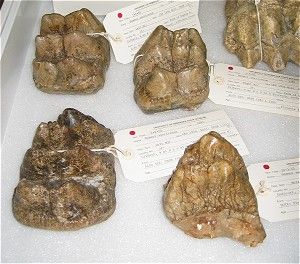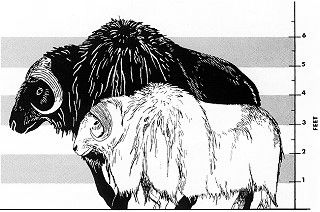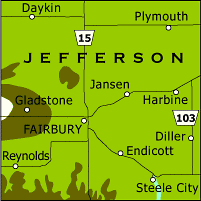
Nebraska County Fossils
Jefferson
< Vertebrate Paleontology Home
A virtual journey through the Museum's vertebrate paleontology collection.
Camelops, Camel
Family: Camelidae
Geologic age: Pleistocene (Early Rancholabrean), about 20 thousand years old
Year fossil collected: 1974


Camels originated in North America and flourished in Nebraska for 40 million years. They evolved into diverse forms, from small llamas to towering giants. Camelops was the last camel survivor in Nebraska and became extinct along with other large ungulates (hoofed animals) about 11,000 years ago. Jefferson County sediments preserve numerous Camelops remains (left).
Mammut americanum, American mastodon
Family: Mammutidae
Geologic age: Pleistocene, about 1 million years old
Year fossil collected: 1953


American Mastodons, though not as common as mammoths, were also widespread across Nebraska. Jefferson County has produced four or five isolated mastodon teeth, a couple of fragmentary jaws, and part of the palate shown below. Teeth are the most durable part of a skeleton, and are often the only remains of an animal to be preserved.
Symbos cavifrons, Helmeted musk ox
Family: Bovidae
Geologic age: Pleistocene (Early Rancholabrean), about 20 thousand years old
Year fossil collected: 1900


Musk Ox today live in the higher latitudes of Canada and Greenland, farther north, in fact, than any other hoofed mammal. They are well adapted to living on sparse tundra vegetation and surviving very long harsh winters. That musk ox are found as fossils in Pleistocene sediments in Nebraska along with fossils of other exclusively northern animals indicates that the climate here was very different 25,000 years ago than it is today. At left is a comparison of the size of the fossil musk ox (black) with the modern (white).
Geological Ages of Rock Formations

| Q | Pleistocene ("Ice Age") Sands, gravels, silts overlay much of the county (not shown) Pleistocene sands, gravels and silts overlay much of Nebraska and often conceal the bedrock beneath. These "Ice Age" deposits often produce the remains of mammoths, bison, horses, musk oxen, elk and other familiar mammals. Small fossils, especially, are important indicators of the climate at the time of deposition. |
| Kc | Cretaceous, Carlisle Formation, 88-92 million years old The Cretaceous Carlisle Shale is composed of a series of dark green to olive sediments ranging from chalk to shale to sandstone, indicating a shallowing of the sea that once covered mid-America. Several transgressions (change in sea level/position of shorelines) took place during the Cretaceous. |
| Kgg | Cretaceous, Greenhorn/Graneros Formations, 92-96 million years old The Graneros Shale/Greenhorn Limestone Formations indicate a transition from a lagoonal/deltaic environment dominated by shales to a deeper water environment where limestone is the predominant sediment. The contact between these formations is usually recognized by a distinctive altered volcanic ash layer (the X-bentonite). |
| Kd | Cretaceous, Dakota Formation, 95-97 million years old The Lower Cretaceous Dakota Formation is exposed in several localities in eastern Nebraska especially along river courses that cut through younger sediments. These yellow, "rusty" sandstones mark the position of the edge of the Cretaceous mid-continental sea at the time of deposition. Few vertebrate fossils have been found in the Dakota Formation, but fossil leaves are common. |
| Pc | Permian, Chase Group, 280-290 million years old Paleozoic rocks, mostly Pennsylvanian and Permian shales and limestones, are exposed in the eastern third of Nebraska, particularly in the southeast. These are mostly marine rocks and contain few vertebrate fossils. Occasional primitive shark teeth or bony fish skeletons are found in the shale units, but these are rare. Those interested in these early vertebrates or in the abundant invertebrate fossils found in these formations should consult the web pages of the Conservation and Survey Division for additional information. |





